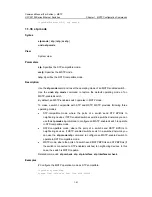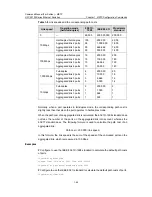
Command Manual (For Soliton) – MSTP
H3C S3100 Series Ethernet Switches
Chapter 1 MSTP Configuration Commands
1-35
z
If a port is configured to connect to a point-to-point link (or non-point-to-point link),
the port adopts the same configuration in all spanning tree instances.
z
If a port connects to a non-point-to-point link, but the port is configured to connect
to a point-to-point link by mistake, loops may temporarily occur.
Related commands:
stp point-to-point
.
Examples
# Configure the link connected to Ethernet 1/0/3 as a point-to-point link.
<Sysname> system-view
System View: return to User View with Ctrl+Z.
[Sysname] stp interface Ethernet 1/0/3 point-to-point force-true
1.1.30 stp interface port priority
Syntax
stp interface interface-list instance instance-id port priority priority
undo stp interface interface-list instance instance-id port priority
View
System view
Parameters
interface-list
: Ethernet port list. You can specify multiple Ethernet ports by providing this
argument in the form of
interface-list =
{
interface-type interface-number
[
to
interface-type interface-number
] } &<1-10>, where &<1-10> means that you can
provide up to 10 port indexes/port index ranges for this argument.
instance-id
: MSTI ID ranging from 0 to 16. The value of 0 refers to the CIST.
priority
: Port priority to be set. This argument ranges from 0 to 240 and must be a
multiple of 16 (such as 0, 16, 32, and so on).
Description
Use the
stp interface port priority
command to set a port priority for the specified
ports in the specified MSTI in system view.
Use the
undo stp interface port priority
command to restore the default priority of the
specified ports in the specified MSTI in system view.
The default port priority of a port in an MSTI is 128.
If you specify the
instance-id
argument to 0, the two commands apply to the port
priorities on the CIST. The role a port plays in an MSTI is affected by its port priority in
the instance. A port on an MSTP-enabled switch can have different port priorities and
play different roles in different MSTIs. This enables packets of different VLANs to be
















































